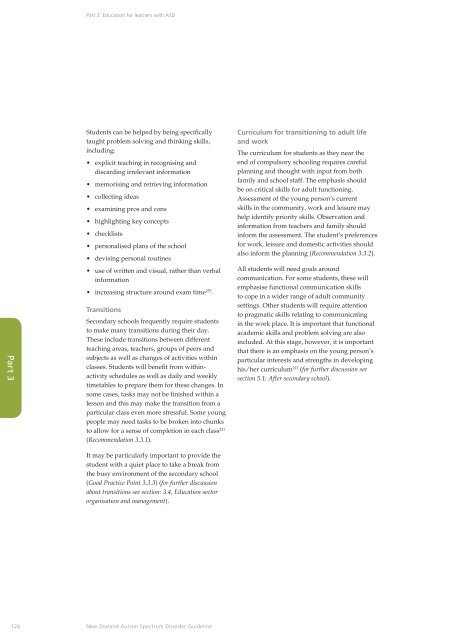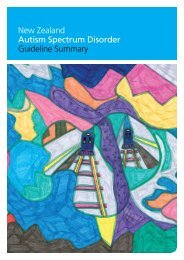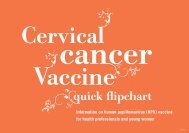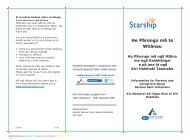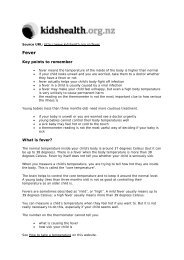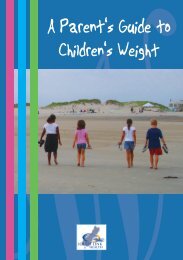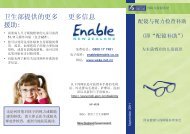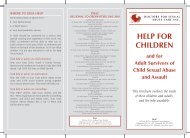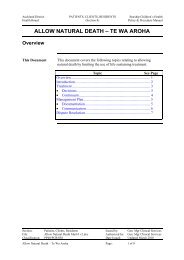New Zealand Autism Spectrum Disorder Guideline - Ministry of Health
New Zealand Autism Spectrum Disorder Guideline - Ministry of Health
New Zealand Autism Spectrum Disorder Guideline - Ministry of Health
You also want an ePaper? Increase the reach of your titles
YUMPU automatically turns print PDFs into web optimized ePapers that Google loves.
Part 3: Education for learners with ASD<br />
Part 3<br />
Students can be helped by being specifically<br />
taught problem solving and thinking skills,<br />
including:<br />
• explicit teaching in recognising and<br />
discarding irrelevant information<br />
• memorising and retrieving information<br />
• collecting ideas<br />
• examining pros and cons<br />
• highlighting key concepts<br />
• checklists<br />
• personalised plans <strong>of</strong> the school<br />
• devising personal routines<br />
• use <strong>of</strong> written and visual, rather than verbal<br />
information<br />
• increasing structure around exam time 255 .<br />
Transitions<br />
Secondary schools frequently require students<br />
to make many transitions during their day.<br />
These include transitions between different<br />
teaching areas, teachers, groups <strong>of</strong> peers and<br />
subjects as well as changes <strong>of</strong> activities within<br />
classes. Students will benefit from withinactivity<br />
schedules as well as daily and weekly<br />
timetables to prepare them for these changes. In<br />
some cases, tasks may not be finished within a<br />
lesson and this may make the transition from a<br />
particular class even more stressful. Some young<br />
people may need tasks to be broken into chunks<br />
to allow for a sense <strong>of</strong> completion in each class 221<br />
(Recommendation 3.3.1).<br />
Curriculum for transitioning to adult life<br />
and work<br />
The curriculum for students as they near the<br />
end <strong>of</strong> compulsory schooling requires careful<br />
planning and thought with input from both<br />
family and school staff. The emphasis should<br />
be on critical skills for adult functioning.<br />
Assessment <strong>of</strong> the young person’s current<br />
skills in the community, work and leisure may<br />
help identify priority skills. Observation and<br />
information from teachers and family should<br />
inform the assessment. The student’s preferences<br />
for work, leisure and domestic activities should<br />
also inform the planning (Recommendation 3.3.2).<br />
All students will need goals around<br />
communication. For some students, these will<br />
emphasise functional communication skills<br />
to cope in a wider range <strong>of</strong> adult community<br />
settings. Other students will require attention<br />
to pragmatic skills relating to communicating<br />
in the work place. It is important that functional<br />
academic skills and problem solving are also<br />
included. At this stage, however, it is important<br />
that there is an emphasis on the young person’s<br />
particular interests and strengths in developing<br />
his/her curriculum 212 (for further discussion see<br />
section 5.1: After secondary school).<br />
It may be particularly important to provide the<br />
student with a quiet place to take a break from<br />
the busy environment <strong>of</strong> the secondary school<br />
(Good Practice Point 3.3.3) (for further discussion<br />
about transitions see section: 3.4, Education sector<br />
organisation and management).<br />
126<br />
<strong>New</strong> <strong>Zealand</strong> <strong>Autism</strong> <strong>Spectrum</strong> <strong>Disorder</strong> <strong>Guideline</strong>


